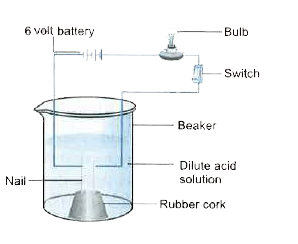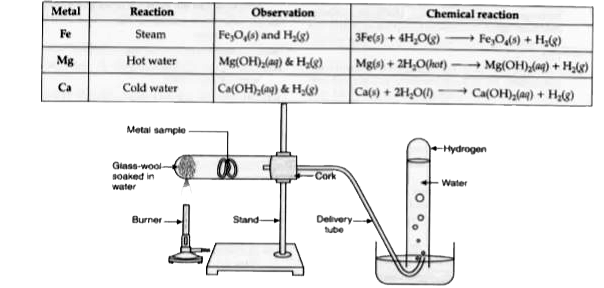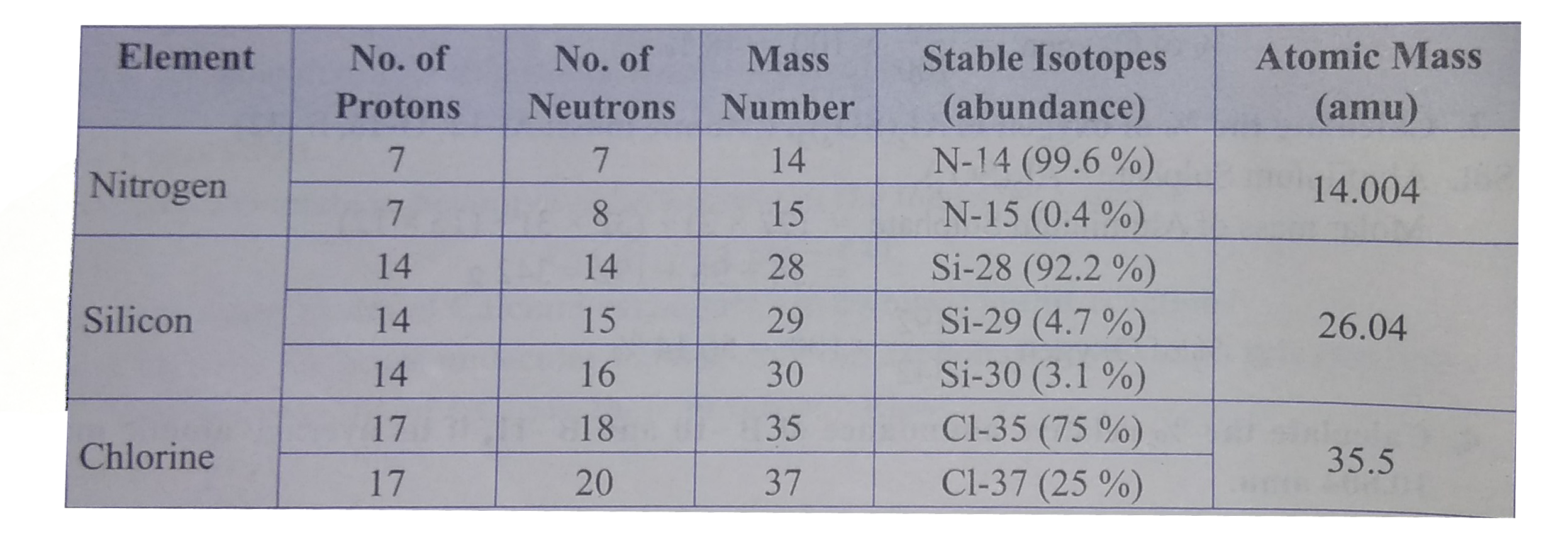InterviewSolution
This section includes InterviewSolutions, each offering curated multiple-choice questions to sharpen your knowledge and support exam preparation. Choose a topic below to get started.
| 6751. |
Convey the following information in the form of a balanced chemical equation: ''An aqueous solution of ferrous sulphate reacts with an aqueous solution of sodium hydroxide to form a precipitate of ferrous hydroxide and sodium sulphate remains in solution.'' |
| Answer» Solution :`FeSO_(4)(aq)+2NaOH(aq)rarrFe(OH)_(2)(s)+Na_(2)SO_(4)(aq)` | |
| 6752. |
Convex mirror is commonly used as rear view mirror in vehicles. Why? |
|
Answer» Solution :They always GIVE an ERECT diminished image. Also they have a wider FIELD of view as they are curved outwards. |
|
| 6753. |
Convert the following statements into balanced chemical equations: (i) Zinc reacts with sulphuric acid to from zinc sulphate and hydrogen gas . Magnesium burns in oxygen to from magnesium oxide. |
|
Answer» SOLUTION :(i) `Zn+H_(2)SO_(4)rarrZnSO_(4)+H_(2)` (ii) `2Mg+O_(2)rarr 2MgO` |
|
| 6754. |
Convert the 69 ^@ C to Kelvin |
|
Answer» 69K |
|
| 6757. |
Convert ‘450 pm’ into SI unit and write the answer in scientific notation upto 2 significant figures. |
|
Answer» |
|
| 6758. |
Convert 150 cm of Aluminium wire into metres |
|
Answer» 1.5 |
|
| 6759. |
Conversion of vegetable oil into ghee is an example for |
|
Answer» OXIDATION reaction |
|
| 6760. |
Conversion of electrical signal to chemical signal occurs at : |
|
Answer» Dentrite of a NEURON |
|
| 6761. |
Consumption of ethanol slow down the metabolism of our body and depresses the central nervous system. |
|
Answer» |
|
| 6762. |
Consider two elements ‘A’ (Atomic number 17) and 'B' (Atomic number 19): (i) Write the positions of these elements in the modern periodic table giving justification. (ii) Write the formula of the compound formed when 'A' combines with 'B.' (iii) Draw the electron dot structure of the compound and state the nature of the bond formed between the two elements. |
Answer» Solution :(i) Position of the elements in the periodic table :  (II) ATOMIC NUMBER of A = 17 Electronic configuration A = 2, 8, 7 Number of valence ELECTRONS of A = 7 Valency of A = 8–7 = 1 Atomic number of B = 19 Electronic configuration B = 2,8,8,1 Number of valence electrons of B = 1 Valency of A =  So, the formula of the compound FORMED when elements A and B combine is BA. (iii) 
|
|
| 6763. |
Consider the reaction CuSO_(4) + Fe to FeSO_(4) + Cu FeSO_(4) + Zn to ZnSO_(4) + Fe |
|
Answer» Zn is most REACTION, FE is least reactive |
|
| 6764. |
Consider the part of periodic table given below and answer the following questions: (i) State the most reactive metal. (ii) How many shells does element d have ? (iii) Identify the element having valency 2. (iv) Write the number of electrons in the valence shell of j. (v) Out of h and i, which element is more non-metallic in nature ? (vi) Out of e and h, which element possess large atomic size? |
| Answer» Solution :(i) d (II) 4 (III) E and g (iv) 2 (v) (VI) e | |
| 6765. |
Consider the isotopes of chlorine, Cl- 35 and Cl-37. would you place them in different slots becauses their atomic masses are different ? Or would you place them in the same position because their chemical properties are the same? |
| Answer» Solution :Since the whole IDEA of classifying elements is based on SIMILARITY in CHEMICAL properties, isotopes should be placed in the same position. | |
| 6766. |
Consider the following statements about an element .X. with number of protons 13. (A) It forms amphoteric oxide.(B) Its valency is three. (C ) The formula of its chloride is XCl_(3). The correct statements(s) is/are |
|
Answer» only (A) |
|
| 6767. |
Consider the following reactions: (i) Fe+CuSO_(4)rarrFeSO_(4)+Cu (ii) Cu+FeSO_(4)rarrCuSO_(4)+Fe Which of these two reactions will take place and why? |
| Answer» Solution :REACTION (i) will TAKE place. This is because FE (IRON) is more reactive than Cu (copper) and so it can displace Cu from its COMPOUND `(CuSO_(4))`. On the other hand, copper (Cu) cannot displace iron (Fe), so reaction (ii) will not take place. | |
| 6768. |
Consider the following elements:Li, Cl, Br, Na, K, I(i) Arrange the elements according to the groups to which they belong in the Periodic Table. (ii) What are the common properties on the basis of which the elements have been groupedtogether? |
|
Answer» Solution : (i) Li, Na and K are grouped together in the periodic table and belong to GROUP I. They aregrouped together because all of them have one electron in their valence shell. Rest of the elements CI, BR and I are grouped together in the periodic table and belong to group 17. (ii) The elements of group 1 are called alkali metals because they react with water to LIBERATE `H_2`GAS and form alkalis. The elements of group 17 are monovalent non-metals. They form acidic oxides and are called halogens. |
|
| 6769. |
Consider the following elements : ""_(20) A, ""_(8) B, ""_(18) C, ""_(16) D, ""_(4) E, ""_(2) F Answer the following giving reasons : Which of the above elements you would expect to be (i) very stable. (ii) in Group 2 of the Periodic Table. (iii) in Group 16 of the Periodic Table. (iv) What type of bond will be formed when the element A reacts with B? Explain. |
|
Answer» Solution :(i) `""_(2) F and ""_(18) C `are very stable elements because they contain 2 (DUPLET) and 8 (OCTET) electrons in the outermost shell. (ii) Elements `""(4)_E and ""_(20) A ` are in Group 2 of the Periodic Table because E has the electronic configuration 2, 2 and A has electronic configuration 2, 8, 8, 2. Both have two electrons in the outermost shell. (iii) `""_(8) B and ""_(16)D` occupy Group 16 of the Periodic Table. Both contain 6 electrons in the outermost shell. (iv) A and B will REACT to FORM AB with an ionic bond. A will donate two electrons to B to form the compound. |
|
| 6770. |
Consider the following chemical reaction : underset("white ppt")(X+" Barium chloride "to Y +" Sodium chloride") Write the type of reaction. |
|
Answer» Solution :It is called DOUBLE displacement REACTION `Na_(2)SO_(4)(aq)+BaCl_(2)(aq)to underset("white ppt")(BaSO_(4)(s))+2NaCl(aq)`. This reaction is also known as PRECIPITATION reaction. |
|
| 6771. |
Consider the following chemical reaction : underset("white ppt")(X+" Barium chloride "to Y +" Sodium chloride") Identify 'X' and 'Y'. |
|
Answer» Solution :X is SODIUM sulphate - `Na_(2)SO_(4)` Y is BARIUM sulphate - `BaSO_(4)` |
|
| 6772. |
Consider the following arrangement of elements : {:(1,2,13,14,15,16,17,18),("Lithium",,,"Carbon",,"Oxygen",L,"Neon"),(X,,,S,,G,Q,),(Y,,,,,,R,),(Z,,,,,,T,):} (a) Which is the most reactive metal? (b) Name the family of L, Q, R, T. (c) Name one element each from the Groups 2, 13, 15. |
|
Answer» Solution :(a) Z is the most reactive metal. (b) Halogens. (C) Magnesium is an element of GROUP 2. BORON is an element of Group 13. Phosphorous is an element of Group 15. |
|
| 6773. |
Consider the following and classify them on the basis of their atomicity. H_(2), "CCl"_(4), O_(3), BF_(3), C_(12)H_(22)O_(11),NO,Cl_(2),He,Au,P_(4), |
|
Answer» Solution :(i) MONO atomic molecule - He, Au (ii) Homo diatomic molecule - `H_(2), Cl_(2)` (iii) Homo triatomic molecule - `O_(3)` (iv) Homo poly atomic molecule - `P_(4)` (v) Hetero diatomic molecule - HCl, NO (vi) Hetero polyatomic molecule - `"CCl"_(4),BF_(3), HNO_(3), C_(12) H_(12)O_(11)` |
|
| 6774. |
Consider the chemical equation given below and answer the questions that follow: CuO+H_(2)overset("Heat")rarrCu+H_(2)O (i) Name the substance which is getting oxidised. (ii) Name the substance which is getting reduced. (iii) Name the oxidising agent. (iv) Name the reducing agent. (v) What type of a reaction does this equation represent? |
|
Answer» SOLUTION :(i) The substance getting oxidised is `H_(2)`. (II) The substance getting reduced is CUO. (iii) CuO is the oxidising agent. (IV) `H_(2)` is the reducing agent. (v) Since oxidation and reduction is taking place simultaneously, this reaction is an example of redox reaction. |
|
| 6775. |
Consider isotopes of oxygen 160 and 180. Would you be able to place them in Mendeleev's Periodic Table? |
| Answer» SOLUTION :No, we cannot PLACE `""^16O` and `""^18O` in Mendeleev.s PERIODIC Table. | |
| 6776. |
"Conscious usage of natural resources nowadays is inevitable". Why? Give reasons for you answer. |
| Answer» Solution :The human population is INCREASING at a tremendous rate due to improvement in HEALTHCARE, the demand for all resources is increasing at an exponential rate. The proper management can ensure that the natural resources are used JUDICIOUSLY so that they fulfillthe needs of present generation and also LAST for the generation to come. The proper management can ensure equitable distribution of natural resources so that all the people can benefit from the development of these resources. | |
| 6777. |
Configurations Designations of sotne orbitals are given below. Identify those configurations that are not possible in an atotn. Arrange the orbitals with possible configurations in the order in which they are filled with electrons 6s, Sp, 7s, 4d, 2p, 3d, 3f, 4f, 1p. |
|
Answer» Solution :1P and 3f are the configurations that are not possible for any orbitals in an atom. All others are possible. The orbitals are occupied by ELECTRONS in increasing ORDER of their ENERGIES. The order of energy is decided by n + e rule. n + l VALUES of orbitals . `6 rarr 6+0=64 d rarr 4+2=6 , 4p rarr 4+1 =5 2p rarr 2+1 =3,` `8 prarr 8+1 =9 3d rarr 3 +2 =5, 7s rarr 7+0 =74f rarr 4+3=7` `2p lt 3d lt 4p lt 6s lt 4f lt 7s lt 8p` |
|
| 6778. |
Conductivity of waterhas resultedfromthe______of Water . |
| Answer» SOLUTION :SELF- IONISATION | |
| 6779. |
Concentrated H2SO4 is a ......... |
| Answer» SOLUTION :DEHYDRATING AGENT | |
| 6780. |
Concentrated Cu_2S is converted into oxide by roasting. How impurities like sulphur and phosphorus are removed in this process? |
|
Answer» |
|
| 6781. |
Concentrated Cu_2S is converted into oxide by roasting. Write the process of roasting. |
|
Answer» |
|
| 6782. |
Conc. Nitric acid render aluminium active due to the formation of ntiride film on its surface . |
|
Answer» |
|
| 6783. |
Compute the heat generated while transferring 96000 coulomb of charge in one hour through a potential difference of 50 V |
|
Answer» Solution :According to Joule.s LAW of heating the AMOUNT of heat produced is given by `H = Vt` where V = 50 V I = charge/time = 9600 Coulomb/1hr = `(96000)/(60 xx 60) = 80/30 A` and t = 1 hr = `60 xx 60 ` sec So `H = 50 xx 80/30 xx 60 xx 60` 4800000 J ` = 4.8 xx 10^6 J` |
|
| 6785. |
Compounds such as alcohols and glucose also contain hydrogen but are not categorised as acids. Describe an activity to prove it. |
|
Answer» Solution :Although alcohols and glucose contain hydrogen but they are not ionised to GIVE `H^(+)` ions solution. So , they are not considered as acid. Activity . `implies` Collect solutions of hydrochloric acid, sulphuric acid , glucose and ALCOHOL. `implies` Take a beaker of 100 Mr. `implies` Now, take a cork and fix two nails on it as shown in figure. Place this cork in the beaker. `implies` CONNECT the nails to the two terminals of a 6 volt battery through a bulb and a switch. `implies` Now , POUR dilute `H_(2)SO_(4)` in the breaker so that the nails are immersed in the acid. Switchon the current . `implies` Repeat the experiment with dilute hydrochloric acid , glucose and alcohol solutions . `implies ` What do you observe ? `implies` Does the bulb GLOW in all cases ? It is observed that the bulb will glow in case of hydrochloric acid sulphuric acid , but not in the case of alcohol and glucose. 
|
|
| 6786. |
Compounds of carbon and hydrogen are called ______(carbohydrates, hydrocarbons) |
| Answer» SOLUTION :HYDROCARBONS | |
| 6787. |
Compounds may be formed by |
|
Answer» DECOMPOSITION of other COMPOUNDS |
|
| 6788. |
………………compounds hold the key to plant and animal life on the earth. |
| Answer» Answer :B | |
| 6789. |
………………compounds decolourize bromine water. |
| Answer» SOLUTION :UNSATURATED | |
| 6790. |
{:(,"Compound","Common Name","IUPAC Name"),(1.,CH_(2)=CH_(2),"Acetylene","Butane"),(2.,CH_(3)-C-=C-CH_(3),"n - butane","Ethene"),(3.,CH_(3)-CH_(2)-CH_(2)-CH_(3),"Dimethyl acetylene","Ethyne"),(4.,CH-=CH,"Ethylene","2 - butyne"):} |
| Answer» SOLUTION :`{:(,"Compound","Common Name","IUPAC Name"),(1.,CH_(2)=CH_(2),"Ethylene","Ethene"),(2.,CH_(3)-C-=C-CH_(3),"Dimethyl acetylene","2 - butyne"),(3.,CH_(3)-CH_(2)-CH_(2)-CH_(3),"N- BUTANE","Butane"),(4.,CH-=CH,"Acetylene","Ethyne"):}` | |
| 6791. |
Compounds such as alcohols and glucose also contain hydrogen but arenot categorised as acids. Describe an Activity to prove it. |
|
Answer» Solution :Two nails are fittedon a cork and are kept in a 100 ML beaker , The nailsare then connected to the two terminals of a 6 voltbattery through a bulb and a switch , Some dilute HCl is poured in the beaker and the current is switch on . The same experiment is then performed with glucose solutions and alcohol solutions. ` (##CPC_SPP_SCI_X_C02_E02_006_S01.png" width="80%"> Obeservation :- It will be observed that the bulb glows in the HCl solutions and does not GLOW in the glucose solutions . Result :- HCl DISSOCIATES into `H^(+) `and `Cl^(-) `ions . These ions CONDUCT ELECTRICITY in the solutions resulting in the glowing of the bulb . on the other hand the glucose solutions does not dissociate into ions . Therefore it does not conduct electricity . Conclusion:- Fromthis activity it canbe concluded that all acids contains hydrogen ions .That is why though alcohols and glucose contains hydrogen , they are not categoresed as acids. |
|
| 6792. |
Compound made-up of only carbon and hydrogen is called .......... |
| Answer» SOLUTION :HYDROCARBON | |
| 6793. |
Compound 'A' when dissolved in water gives compound 'B'which is used in whitewashing. Compound 'B' reacts with CO_(2) to form a white precipitate of compound 'C'. Identify compounds 'A', 'B' and 'C'. Also write the equations involved. |
|
Answer» Solution :`.A.undersetundersetoverset("Exothermic")("reaction")rarr(+H_(2)O)underset("whitewashing")underset("Used for")(.B.)+CO_(2)rarrunderset("White ppt")(.C.)` Slaked lime `[(CA(OH)_(2)]` is used for whitewashing. It is obtained when quicklime, CAO reacts with water. `underset("Quicklime")(CaO)+H_(2)Orarrunderset(("Slaked lime"))underset("Calcium hydroxide")(Ca(OH)_(2))+"Heat"` So .A. is CaO and .B. is `Ca(OH)_(2)`. `Ca(OH)_(2)(aq)+CO_(2)(g)rarrundersetunderset(("White ppt."))("Calcium CARBONATE")(CaCO_(3)(s))+H_(2)O(l)` .C. is `CaCO_(3)`. |
|
| 6794. |
Compositionof thenucleiof twoatomicspeciesX and Yaregiven. {:(,X,Y),("Proton ",8,8),("Neutrons" ,8,10):} Givethe massnumberofX andY . Whatis therelationbetweenthe twospecies ? |
|
Answer» SOLUTION :MassnumberofX = 8 +8 = 16, Elementis `""_(8)O^(16)` MASSOF NUMBERY = 8 +10 = 18 , Elementis ` ""_(8) O^(18)` X andYare ISOTOPES . |
|
| 6795. |
Compose an activity to arrange Ca, Mg and Fe metals in the decreasing order of reactivity with water. Write suitable balanced chemical equations and draw diagrams. |
Answer» Solution :Take some metals like Ca, Mg and Fe etc. PLACE separately small pieces of these metals in beakers with small amount of water in them. If the metals react with the cold water, then the reaction is vigorous. If metals does not react with cold water, then treat it with HOT water. Record the observations and arrange the metals in DECREASING order of reactivity.  After this ACTIVITY it can be CONCLUDED that Ca is more reactivity than Mg, which is more creative than Fe. |
|
| 6796. |
Complete the reaction(s) given below and classify them as Combustion/Oxidation/Addition/Substitution reaction. (i) CH_(3)CH_(2)CH_(2)OH underset("Heat")overset("alk. "KMnO_(4))to "" (ii) C_(2)H_(4)+H_(2) overset("Ni catalyst")to |
| Answer» Solution :`(i) CH_(3)CH_(2)COOH`, Oxidation`(II) C_(2)H_(6)`, ADDITION. | |
| 6797. |
Complete the reaction : CH_(3)COONa + NaOH overset(CaO)rarr |
| Answer» Solution :`CH_(3)COONA + NaOH overset(CaO)rarr CH_(4) + Na_(2)CO_(3)` | |
| 6798. |
Completethe reaction 2Al+2NaOH + 2 H_2O to" _____" + 3H_2 uarr |
| Answer» SOLUTION :`2Al+2NaOH _ 2H_2O to 2NA AlO_2 + 3H_2 UARR ` | |
| 6799. |
Complete the missing components/variables given as x and y in the following reactions (a) Pb(NO_(3))_(2) (aq) + 2KI(aq) to PbI_(2)(x) + 2KNO_(3)(y) (b) Cu(s) + 2AgNO_(3)(aq) to Cu(NO_(3))_(2)(aq) + x(s) (c) Zn(s) + H_(2)SO_(4)(aq) to ZnSO_(4)(x) + H_(2)(y) (d) CaCO_(3)(s) overset(x)to CaO(s) + CO_(2)(g) |
|
Answer» SOLUTION :(i) `X-(s),y-(AQ)` (ii) `x-2Ag` (iii) `x-(aq),y-(g)` (IV) `x-"HEAT"` |
|
| 6800. |
Complete the following table by filling the appropriate values/terms |
Answer» SOLUTION :
|
|